Guoqing Zheng
Phi-4-reasoning Technical Report
Apr 30, 2025Abstract:We introduce Phi-4-reasoning, a 14-billion parameter reasoning model that achieves strong performance on complex reasoning tasks. Trained via supervised fine-tuning of Phi-4 on carefully curated set of "teachable" prompts-selected for the right level of complexity and diversity-and reasoning demonstrations generated using o3-mini, Phi-4-reasoning generates detailed reasoning chains that effectively leverage inference-time compute. We further develop Phi-4-reasoning-plus, a variant enhanced through a short phase of outcome-based reinforcement learning that offers higher performance by generating longer reasoning traces. Across a wide range of reasoning tasks, both models outperform significantly larger open-weight models such as DeepSeek-R1-Distill-Llama-70B model and approach the performance levels of full DeepSeek-R1 model. Our comprehensive evaluations span benchmarks in math and scientific reasoning, coding, algorithmic problem solving, planning, and spatial understanding. Interestingly, we observe a non-trivial transfer of improvements to general-purpose benchmarks as well. In this report, we provide insights into our training data, our training methodologies, and our evaluations. We show that the benefit of careful data curation for supervised fine-tuning (SFT) extends to reasoning language models, and can be further amplified by reinforcement learning (RL). Finally, our evaluation points to opportunities for improving how we assess the performance and robustness of reasoning models.
AgentInstruct: Toward Generative Teaching with Agentic Flows
Jul 03, 2024



Abstract:Synthetic data is becoming increasingly important for accelerating the development of language models, both large and small. Despite several successful use cases, researchers also raised concerns around model collapse and drawbacks of imitating other models. This discrepancy can be attributed to the fact that synthetic data varies in quality and diversity. Effective use of synthetic data usually requires significant human effort in curating the data. We focus on using synthetic data for post-training, specifically creating data by powerful models to teach a new skill or behavior to another model, we refer to this setting as Generative Teaching. We introduce AgentInstruct, an extensible agentic framework for automatically creating large amounts of diverse and high-quality synthetic data. AgentInstruct can create both the prompts and responses, using only raw data sources like text documents and code files as seeds. We demonstrate the utility of AgentInstruct by creating a post training dataset of 25M pairs to teach language models different skills, such as text editing, creative writing, tool usage, coding, reading comprehension, etc. The dataset can be used for instruction tuning of any base model. We post-train Mistral-7b with the data. When comparing the resulting model Orca-3 to Mistral-7b-Instruct (which uses the same base model), we observe significant improvements across many benchmarks. For example, 40% improvement on AGIEval, 19% improvement on MMLU, 54% improvement on GSM8K, 38% improvement on BBH and 45% improvement on AlpacaEval. Additionally, it consistently outperforms other models such as LLAMA-8B-instruct and GPT-3.5-turbo.
Axiomatic Preference Modeling for Longform Question Answering
Dec 02, 2023



Abstract:The remarkable abilities of large language models (LLMs) like GPT-4 partially stem from post-training processes like Reinforcement Learning from Human Feedback (RLHF) involving human preferences encoded in a reward model. However, these reward models (RMs) often lack direct knowledge of why, or under what principles, the preferences annotations were made. In this study, we identify principles that guide RMs to better align with human preferences, and then develop an axiomatic framework to generate a rich variety of preference signals to uphold them. We use these axiomatic signals to train a model for scoring answers to longform questions. Our approach yields a Preference Model with only about 220M parameters that agrees with gold human-annotated preference labels more often than GPT-4. The contributions of this work include: training a standalone preference model that can score human- and LLM-generated answers on the same scale; developing an axiomatic framework for generating training data pairs tailored to certain principles; and showing that a small amount of axiomatic signals can help small models outperform GPT-4 in preference scoring. We release our model on huggingface: https://huggingface.co/corbyrosset/axiomatic_preference_model
Orca 2: Teaching Small Language Models How to Reason
Nov 21, 2023



Abstract:Orca 1 learns from rich signals, such as explanation traces, allowing it to outperform conventional instruction-tuned models on benchmarks like BigBench Hard and AGIEval. In Orca 2, we continue exploring how improved training signals can enhance smaller LMs' reasoning abilities. Research on training small LMs has often relied on imitation learning to replicate the output of more capable models. We contend that excessive emphasis on imitation may restrict the potential of smaller models. We seek to teach small LMs to employ different solution strategies for different tasks, potentially different from the one used by the larger model. For example, while larger models might provide a direct answer to a complex task, smaller models may not have the same capacity. In Orca 2, we teach the model various reasoning techniques (step-by-step, recall then generate, recall-reason-generate, direct answer, etc.). More crucially, we aim to help the model learn to determine the most effective solution strategy for each task. We evaluate Orca 2 using a comprehensive set of 15 diverse benchmarks (corresponding to approximately 100 tasks and over 36,000 unique prompts). Orca 2 significantly surpasses models of similar size and attains performance levels similar or better to those of models 5-10x larger, as assessed on complex tasks that test advanced reasoning abilities in zero-shot settings. make Orca 2 weights publicly available at aka.ms/orca-lm to support research on the development, evaluation, and alignment of smaller LMs
Sweeping Heterogeneity with Smart MoPs: Mixture of Prompts for LLM Task Adaptation
Oct 05, 2023


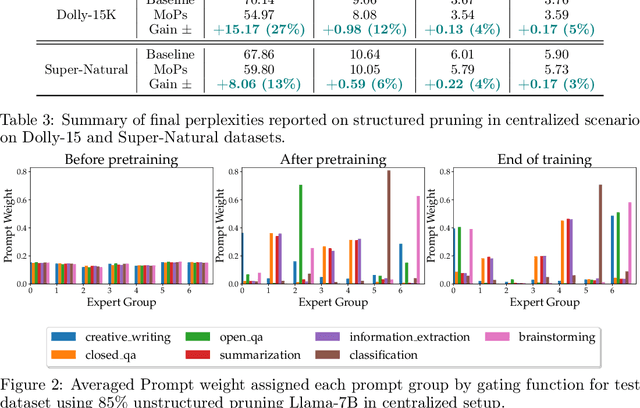
Abstract:Large Language Models (LLMs) have the ability to solve a variety of tasks, such as text summarization and mathematical questions, just out of the box, but they are often trained with a single task in mind. Due to high computational costs, the current trend is to use prompt instruction tuning to better adjust monolithic, pretrained LLMs for new -- but often individual -- downstream tasks. Thus, how one would expand prompt tuning to handle -- concomitantly -- heterogeneous tasks and data distributions is a widely open question. To address this gap, we suggest the use of \emph{Mixture of Prompts}, or MoPs, associated with smart gating functionality: the latter -- whose design is one of the contributions of this paper -- can identify relevant skills embedded in different groups of prompts and dynamically assign combined experts (i.e., collection of prompts), based on the target task. Additionally, MoPs are empirically agnostic to any model compression technique applied -- for efficiency reasons -- as well as instruction data source and task composition. In practice, MoPs can simultaneously mitigate prompt training "interference" in multi-task, multi-source scenarios (e.g., task and data heterogeneity across sources), as well as possible implications from model approximations. As a highlight, MoPs manage to decrease final perplexity from $\sim20\%$ up to $\sim70\%$, as compared to baselines, in the federated scenario, and from $\sim 3\%$ up to $\sim30\%$ in the centralized scenario.
Hybrid Retrieval-Augmented Generation for Real-time Composition Assistance
Aug 08, 2023



Abstract:Retrieval augmented models show promise in enhancing traditional language models by improving their contextual understanding, integrating private data, and reducing hallucination. However, the processing time required for retrieval augmented large language models poses a challenge when applying them to tasks that require real-time responses, such as composition assistance. To overcome this limitation, we propose the Hybrid Retrieval-Augmented Generation (HybridRAG) framework that leverages a hybrid setting that combines both client and cloud models. HybridRAG incorporates retrieval-augmented memory generated asynchronously by a Large Language Model (LLM) in the cloud. By integrating this retrieval augmented memory, the client model acquires the capability to generate highly effective responses, benefiting from the LLM's capabilities. Furthermore, through asynchronous memory integration, the client model is capable of delivering real-time responses to user requests without the need to wait for memory synchronization from the cloud. Our experiments on Wikitext and Pile subsets show that HybridRAG achieves lower latency than a cloud-based retrieval-augmented LLM, while outperforming client-only models in utility.
Fed-ZERO: Efficient Zero-shot Personalization with Federated Mixture of Experts
Jun 14, 2023



Abstract:One of the goals in Federated Learning (FL) is to create personalized models that can adapt to the context of each participating client, while utilizing knowledge from a shared global model. Yet, often, personalization requires a fine-tuning step using clients' labeled data in order to achieve good performance. This may not be feasible in scenarios where incoming clients are fresh and/or have privacy concerns. It, then, remains open how one can achieve zero-shot personalization in these scenarios. We propose a novel solution by using a Mixture-of-Experts (MoE) framework within a FL setup. Our method leverages the diversity of the clients to train specialized experts on different subsets of classes, and a gating function to route the input to the most relevant expert(s). Our gating function harnesses the knowledge of a pretrained model common expert to enhance its routing decisions on-the-fly. As a highlight, our approach can improve accuracy up to 18\% in state of the art FL settings, while maintaining competitive zero-shot performance. In practice, our method can handle non-homogeneous data distributions, scale more efficiently, and improve the state-of-the-art performance on common FL benchmarks.
Learning with Few Labeled Nodes via Augmented Graph Self-Training
Aug 26, 2022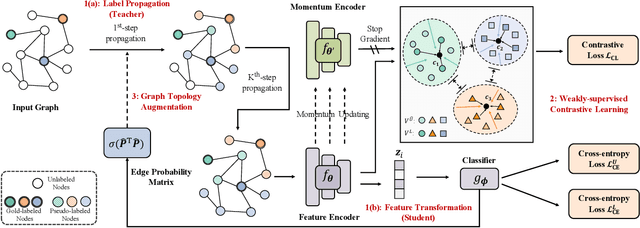
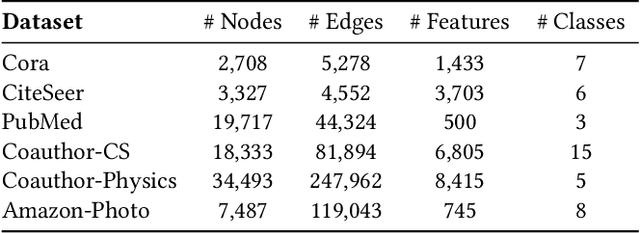
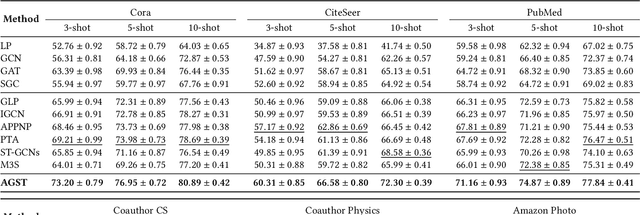
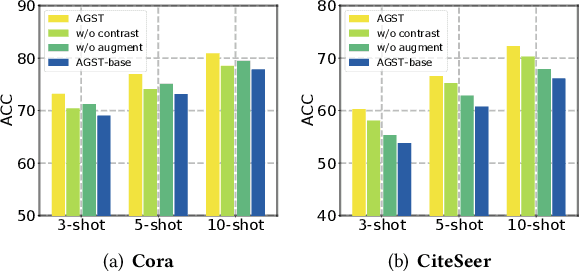
Abstract:It is well known that the success of graph neural networks (GNNs) highly relies on abundant human-annotated data, which is laborious to obtain and not always available in practice. When only few labeled nodes are available, how to develop highly effective GNNs remains understudied. Though self-training has been shown to be powerful for semi-supervised learning, its application on graph-structured data may fail because (1) larger receptive fields are not leveraged to capture long-range node interactions, which exacerbates the difficulty of propagating feature-label patterns from labeled nodes to unlabeled nodes; and (2) limited labeled data makes it challenging to learn well-separated decision boundaries for different node classes without explicitly capturing the underlying semantic structure. To address the challenges of capturing informative structural and semantic knowledge, we propose a new graph data augmentation framework, AGST (Augmented Graph Self-Training), which is built with two new (i.e., structural and semantic) augmentation modules on top of a decoupled GST backbone. In this work, we investigate whether this novel framework can learn an effective graph predictive model with extremely limited labeled nodes. We conduct comprehensive evaluations on semi-supervised node classification under different scenarios of limited labeled-node data. The experimental results demonstrate the unique contributions of the novel data augmentation framework for node classification with few labeled data.
ADMoE: Anomaly Detection with Mixture-of-Experts from Noisy Labels
Aug 24, 2022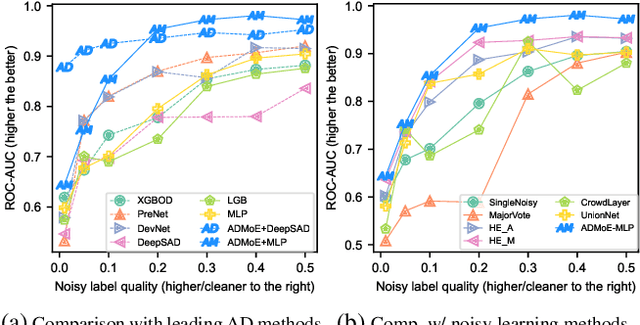


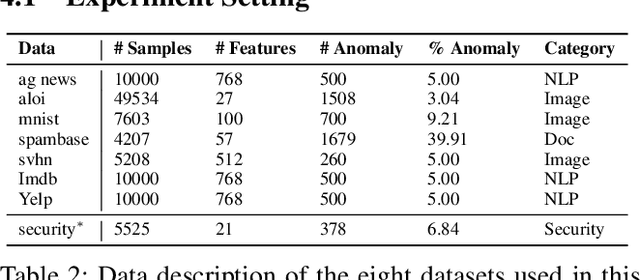
Abstract:Existing works on anomaly detection (AD) rely on clean labels from human annotators that are expensive to acquire in practice. In this work, we propose a method to leverage weak/noisy labels (e.g., risk scores generated by machine rules for detecting malware) that are cheaper to obtain for anomaly detection. Specifically, we propose ADMoE, the first framework for anomaly detection algorithms to learn from noisy labels. In a nutshell, ADMoE leverages mixture-of-experts (MoE) architecture to encourage specialized and scalable learning from multiple noisy sources. It captures the similarities among noisy labels by sharing most model parameters, while encouraging specialization by building "expert" sub-networks. To further juice out the signals from noisy labels, ADMoE uses them as input features to facilitate expert learning. Extensive results on eight datasets (including a proprietary enterprise security dataset) demonstrate the effectiveness of ADMoE, where it brings up to 34% performance improvement over not using it. Also, it outperforms a total of 13 leading baselines with equivalent network parameters and FLOPS. Notably, ADMoE is model-agnostic to enable any neural network-based detection methods to handle noisy labels, where we showcase its results on both multiple-layer perceptron (MLP) and the leading AD method DeepSAD.
Pathologies of Pre-trained Language Models in Few-shot Fine-tuning
Apr 17, 2022
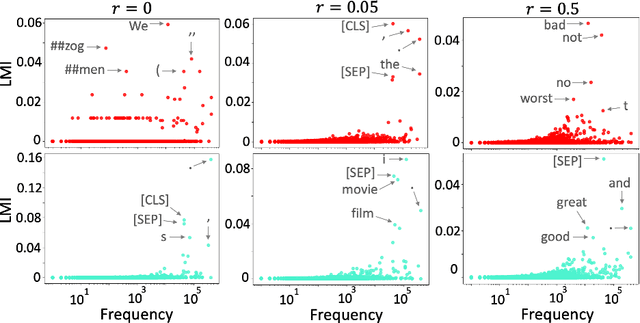
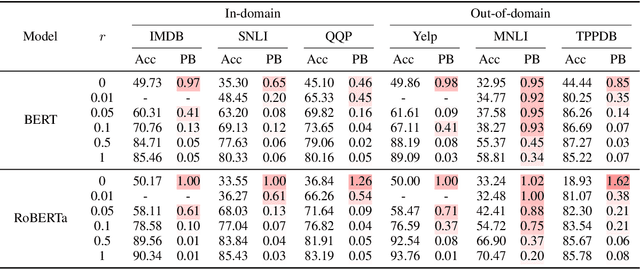
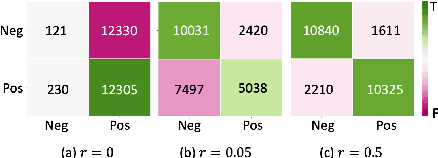
Abstract:Although adapting pre-trained language models with few examples has shown promising performance on text classification, there is a lack of understanding of where the performance gain comes from. In this work, we propose to answer this question by interpreting the adaptation behavior using post-hoc explanations from model predictions. By modeling feature statistics of explanations, we discover that (1) without fine-tuning, pre-trained models (e.g. BERT and RoBERTa) show strong prediction bias across labels; (2) although few-shot fine-tuning can mitigate the prediction bias and demonstrate promising prediction performance, our analysis shows models gain performance improvement by capturing non-task-related features (e.g. stop words) or shallow data patterns (e.g. lexical overlaps). These observations alert that pursuing model performance with fewer examples may incur pathological prediction behavior, which requires further sanity check on model predictions and careful design in model evaluations in few-shot fine-tuning.
 Add to Chrome
Add to Chrome Add to Firefox
Add to Firefox Add to Edge
Add to Edge